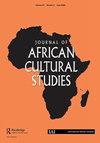卡伦津族传统歌曲的演变、转变与趋势
IF 0.9
2区 社会学
Q2 CULTURAL STUDIES
引用次数: 0
摘要
摘要自从20世纪20年代卡伦津最早的传统专辑问世以来,社区的传统歌曲已经发生了演变和变革。本文通过考察这些歌曲是如何从Kambaget(体育比赛)期间表演的民歌,以及从Bekyibei arap Mosonik、Kipchamba arap Tapotuk及其同时代人的最早作品,到现代卡伦津流行歌曲,来追溯这一历史过程的。这篇文章记录了卡伦津音乐曲目和乐队的最早录音,并追溯了基普尚巴Koilong'et乐队从20世纪40年代和后来几十年的艺术家到20世纪90年代、21世纪初和今天的年轻一代的遗产。这样做是为了确定接触区域以及与典型和流行的卡伦津传统歌曲的不同。本文以20世纪90年代无线电波的解放为焦点,分析了《老年人》的非凡多样性和复杂性,并将其与当代艺术产品进行了比较,这些产品回收了这一历史经典的某些方面。本文章由计算机程序翻译,如有差异,请以英文原文为准。
Evolutions, Transformations and Trends in Kalenjin Traditional Songs
ABSTRACT Since the production of the earliest Kalenjin traditional albums in the 1920s, the community’s traditional songs have evolved and transformed. This article traces this historical process by considering how these songs developed from folk songs performed during Kambaget (sports competitions) and from the earliest compositions of Bekyibei arap Mosonik, Kipchamba arap Tapotuk and their contemporaries, to the modern-day Kalenjin popular hits. The article documents the earliest recordings of Kalenjin music tracks as well as the bands, and traces the legacies of Kipchamba’s Koilong’et Band from the artists of 1940s and those of the later decades through to the younger generations of the 1990s, 2000s and today. This is done in order to determine the zones of contact as well as departures from prototypical and popular Kalenjin traditional songs. Taking the 1990s liberation of the airwaves as focus, this essay analyses the extraordinary variety and complexity of “The Oldies” and compares these to contemporary artistic products that have recycled aspects of this historical canon.
求助全文
通过发布文献求助,成功后即可免费获取论文全文。
去求助
来源期刊

Journal of African Cultural Studies
Multiple-
CiteScore
1.70
自引率
10.00%
发文量
13
期刊介绍:
The Journal of African Cultural Studies publishes leading scholarship on African culture from inside and outside Africa, with a special commitment to Africa-based authors and to African languages. Our editorial policy encourages an interdisciplinary approach, involving humanities, including environmental humanities. The journal focuses on dimensions of African culture, performance arts, visual arts, music, cinema, the role of the media, the relationship between culture and power, as well as issues within such fields as popular culture in Africa, sociolinguistic topics of cultural interest, and culture and gender. We welcome in particular articles that show evidence of understanding life on the ground, and that demonstrate local knowledge and linguistic competence. We do not publish articles that offer mostly textual analyses of cultural products like novels and films, nor articles that are mostly historical or those based primarily on secondary (such as digital and library) sources. The journal has evolved from the journal African Languages and Cultures, founded in 1988 in the Department of the Languages and Cultures of Africa at the School of Oriental and African Studies, London. From 2019, it is published in association with the International African Institute, London. Journal of African Cultural Studies publishes original research articles. The journal also publishes an occasional Contemporary Conversations section, in which authors respond to current issues. The section has included reviews, interviews and invited response or position papers. We welcome proposals for future Contemporary Conversations themes.
 求助内容:
求助内容: 应助结果提醒方式:
应助结果提醒方式:


